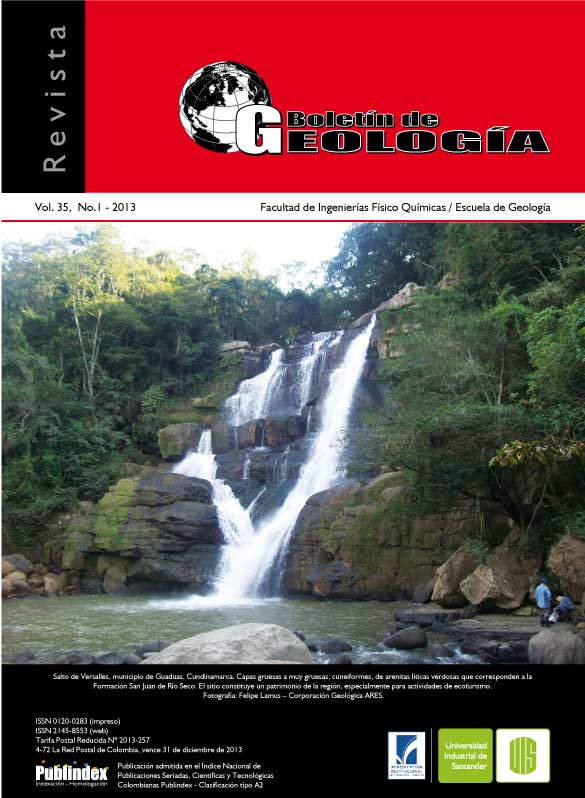PROVENANCE OF CENOZOIC UNITS OF THE GUADUAS SYNCLINE: IMPLICATION IN THE TECTONIC EVOLUTION OF THE SOUTH OF MIDDLE MAGDALENA VALLEY AND ADJACENT OROGENS
Published 2013-05-31
How to Cite
Abstract
The understanding of the evolution of a basin is linked to the comprehension of various factors controlling basin-filling processes and orogen deformation. Integrated provenance analyzes (clasts counts of conglomerates, petrography, heavy minerals and detrital geochronology), in the Maastrichtian to Miocene units exposed in three areas of the Guaduas Syncline (western foothill of the Eastern Cordillera), were conducted to determine timing of deformation of bounding orogens and intrabasinal uplifts, and the tectonic implications within the basin.
The Cenozoic clastic wedge shows significant variation in compositions and detrital zircon populations, as indicated by the analysis in the conglomerate and sandstone fraction. Clast counting in conglomerate beds of three stratigraphic units show quartzose-rich intervals in Upper Cretaceous and middle Eocene to upper Oligocene strata, whereas Paleocene - middle Eocene strata included an increase of lithic rock fragments up to 83%. Sandstone composition varies from Litharenites, Feldspathic Litharenites and Sublitharenites, documenting erosion from recycled quartzose orogenic systems for Maastrichtian and lower Eocene strata to recycled transitional orogenic systems in middle Eocene to lower Miocene strata. The Heavy minerals also show, as the conglomerates, an increase of ultrastable minerals in quartzose strata, whereas in Paleocene - middle Eocene strata dominate unstable heavy minerals. The integration of detrital geochronology results shows a dominance of Upper Cretaceous zircon populations in Maastrichtian to lower Eocene strata, whereas in younger strata Jurassic zircon ages dominate. These changes in composition and detrital zircon populations imply that rock composition and ages within the possible source areas were not always the same, and even in the same source area may be shift in rock composition and ages along strike.
The results allow document three deformation events from the Maastrichtian to Middle Miocene. The first event relates to eastward-tilting of the Cordillera Central with denudation of Cretaceous intrusive rocks (Antioqueño Batholith) and onset of fault reactivation along the western flank of the Eastern Cordillera between 70-49 Ma. The second event is associated to intrabasinal (wrenching) deformation during Early to Middle Eocene (52-40 Ma), and northward movement of the Central Cordillera. The third event corresponds to the combined effect of the growth of the deformation on the western flank of the Eastern Cordillera, and denudation of the Jurassic intrusives of the eastern flank of the Central Cordillera. It is worth highlighting as the use of multiple tools can begin to differentiate provenance sources within the same orogen, as the Central Cordillera with north migration, and even reworking of Cenozoic rocks due to intrabasin highs associated with transverse faults.
The cessation in the Early Eocene of volcanic activity in the Central Cordillera and strike-slip deformation in the Central Cordillera and adjacent basin may be related to a change in the style of convergence from orthogonal during the Paleocene, to oblique during the middle Eocene. In the Oligocene, orthogonal convergence resumed, as indicated by the reactivation of the Bituima fault system and restarting magmatic activity in the Central Cordillera Colombia.
Keywords: Provenance Analysis, Guaduas Syncline, Cordillera Oriental.
Downloads
References
Bayona, G., Lamus, F., Cardona, A., Jaramillo, C., Montes, C., y Tchegliakova, N. 2007. Procesos Orogénicos del Paleoceno para la cuenca de Ranchería (Guajira, Colombia) definidos por análisis de procedencia. Geología Colombiana, 32: 21-46.
Bayona, G., Cortes, M., Jaramillo, C., Ojeda, G., Aristizabal, J., and Reyes-Harker, A. 2008. An integrated analysis of an orogen-sedimentary basin pair: Latest Cretaceous-Cenozoic evolution of the linked Eastern Cordillera orogen and the Llanos foreland basin of Colombia. Geological Society of America Bulletin, 120: 1171-1197.
Bayona, G., Cardona, A., Jaramillo, C., Mora, A., Montes, C., Caballero, V., Mahecha, H., Lamus, F., Montenegro, O., Jiménez, G., Mesa, A., and Valencia, V. 2013. Onset of fault reactivation in the Eastern Cordillera of Colombia and proximal Llanos basin; response to Caribbean – South American collision in early Palaeogene time. In: Thick-Skin-Dominated Orogens: From Initial Inversion to Full Accretion. (Nemcok, M., Mora, A.R., and Cosgrove, J.W. Eds.) Journal of the Geological Society of London, Special Publication, 377
Caballero, V., Parra, M., Mora, A., López, C., Rojas, E., and Quintero, I. 2013: Factors controlling selective abandonment and reactivation in thick skin orogens: A case study in the Magdalena Valley, Colombia. In: Thick-Skin-Dominated Orogens: From Initial Inversion to Full Accretion Nemcok, M., Mora, A.R., and Cosgrove, J.W. Eds.) Journal of the Geological Society of London, Special Publication, 377.
Cardona, A., Valencia, V.A., Bayona, G., Duque, J., Ducea, M., Gehrels, G. Jaramillo, C., Montes, C., Ojeda, G., and Ruiz, J. 2011. Early-subduction-related orogeny in the northern Andes: Turonian to Eocene magmatic and provenance record in the Santa Marta Massif and Rancheria Basin, northern Colombia. Terra Nova, 23: 26-34.
Cediel, F., Shaw, R., and Cáceres, C. 2003. Tectonic Assembly of the Northern Andean Block. In: The Circum-Gulf of Mexico and the Caribbean: Hydrocarbon Habitats, Basin Formation and Plate Tectonics(Bartolini, C., Buffler R., Blickwede, J. Ed.), American Association of Petroleum Geologists Memoir 79, pp.815-848
Colleta, B., Hébrard, F., Letouzey, J., Werner, P., and Rudkiewikz, J.L. 1990. Tectonic Style and Crustal Structure of the Eastern Cordillera (Colombia), from a Balanced Cross Section. In: Petroleum and Tectonics in Mobile Belts (Letouzey, J. Ed)., Editions Technip., Paris, pp.81-100
Cooper, M.A., Addison, F.T., Alvarez, R., Coral, M., Graham, R.H., Hayward, A.B., Howe, S., Martinez, J., Naar, J., Peñas, R., Pulham, A.J., and Taborda, A. 1995
